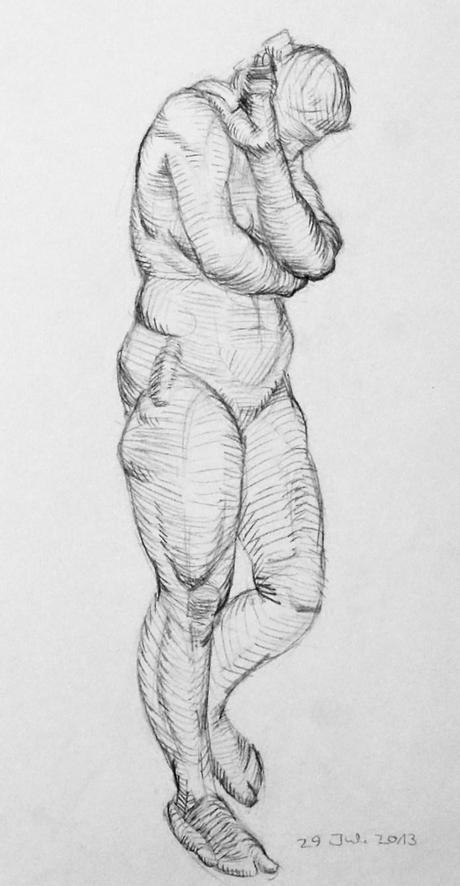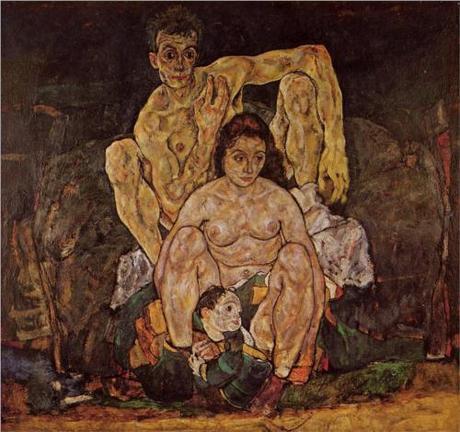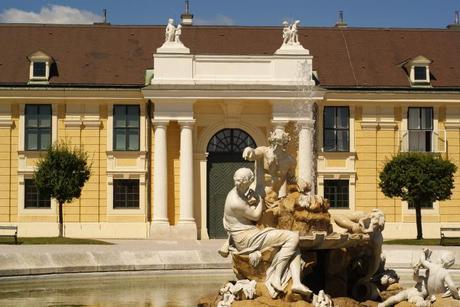
Copy after Rodin, Eve, Oberes Belvedere, Wien
In Vienna, a little romance has blossomed between me and sculpture. It’s hard to say how this happened; it unfolded slowly, and now I am irresistibly drawn to these three-dimensional creatures that transform before my eyes as I circle them. So rich in possibilities! So imaginative in design! Endless drawings grasp after these bronze, marble and terracotta constructions, with each viewpoint a new vision, a new insight.
In one of his more lighthearted moments, Kafka, too, relished the magic of sculpture. Of a trip to the Louvre he writes in his diaries (p. 459-60):
‘Even when you walked around the Venus de Milo as slowly as possible, there was a rapid and surprising alteration in its appearance. … I should need a plastic reproduction to remember them, especially one about the way the bended left knee affected her appearance from every side, though sometimes only very slightly. …
The front view of the Borghese Wrestler isn’t the best one, for it makes the spectator recoil and presents a disjointed appearance. Seen from the rear, however, where for the first time you see his foot touching the ground, your eye is drawn in delight along the rigid leg and flies safely over the irresistible back to the arm and sword raised towards the front.’
The sculptor must be a mannerist, for in sculpture the figure stands alone, no background to compositionally support it. Perhaps a lute or some drapery bend space in the desired way, but these too mustn’t stray too far from the figure, and must be supported somehow. This is the human form at its most expressive! Extended arms in theatrical gestures; cocked hips and crunched abdomens; exaggerated sweeps of legs and improbable stacks of pelvises and rib cages supported by ruthless gravity but given wings by imagination.
Kenneth Clark (p. 357) surprisingly suggests that ‘to use the body as a means of expressing the anguish of the human soul is no longer a possible enterprise.’ He concludes his book The Romantic Rebellion with a chapter on Rodin, whose Eve I have been fawning over in the Upper Belvedere, seeming to situate Rodin at the end of an era in the expressive relevance of the human form. Perhaps he is historically correct in this; as Kandel (p. 215) argues, the emergence of modernism was signalled by the advent of ‘two broad, sometimes overlapping types of experiments, both designed to enlarge the viewer’s experience in ways that photography could not’: specifically, one loose camp of artists proceeded to dissect the physicality of painting, toying with perspective and form and such representational tools to produce something visually challenging. The second broad camp of artists used all available tools to explore the psyche, and the visual representation of emotions. Historically, then, there seems, in the wake of Rodin, no place for the realistic representation of the human figure when abstraction, symbolism and expressive distortions have picked up where he left off.
However, Clark (p. 357) offers an insightful reason for the impossibility of continuing Rodin’s powerful tradition: ‘We do not know how to represent the body and do not believe in the existence of the soul.’ The first contention seems fair, yet surmountable. It’s certainly more difficult now to learn solid draughtsmanship, and to be guided on points of form and anatomy, but schools exist, and individuals persevere. The second point is more difficult to dodge, and seems to resonate with Nietzsche’s fearless observation of the beliefs of his fellow human beings that God is dead. We are crying out for a new metaphor, a new way to describe that restlessness within us, that feeling intellect, that thoughtful sentience. We are wed to this earth by our bodies of dirt, held fast by gravity. But we feel more than mere pain and pleasure, and are propelled by more than instinct.

Copy after Rodin, Eve, Oberes Belvedere, Wien
Rodin’s Eve clings to the old metaphor but in a way unlike any other I’ve seen: her belly beginning to bulge, she clutches herself in shame and misery at the wounded world she is to birth. She shields her head, hung low and dark, with a hastily-sculpted hand, shying from the blame she is to wear for all of womankind for her curious and defiant actions. Not a seductive temptress proffering jewel-like fruit to her unsuspecting and guileless male companion, not a sparkling goddess of fertility; Rodin’s Eve probes the devastation of the first act in the tragedy that is our western metaphor and reveals that metaphor for the failure that it is, and the failure that it has forced us to be from the beginning.

Egon Schiele, The Family, Belvedere Wien
Rodin’s truth is ugly, but apt and timely. The man himself says (in Kandel, p. 103), ‘There is nothing ugly in art except that which is without character, that is to say that which offers no outer or inner truth.’ Rodin himself begins to turn inwards in a way that aligns with the Viennese expressionists, including Schiele and Kokoschka, who ‘produced work that boldly challenged the aesthetic focus on beauty and the association of beauty with truth’ (p. 102), and who themselves turned inwards. Interestingly, however, while their paintings distorted the human figure, they relied heavily on gestural symbolism within the figure, returning again and again to the expressiveness of human hands, as well as playing with the meanings implied by awkward angularities and physical relations between figures. I return again and again to Schiele’s The Family in the Belvedere, where Schiele, ape-like, drapes his protective but awkward arms around his wife Edith, who sits serenely between his legs, where she received the fruit of his loins, and her own legs are parted, knees raised high, to introduce their inquisitive child into the world from between her own fruitful thighs. There is a vulgarity in this, but a beautiful honesty relevant to the age. And it is not thoroughly severed from the knowledgeable representation of the human form (Schiele’s anatomical knowledge is always prominent), though it distorts and in some ways caricatures.
Schiele, then, provides an apt example for Nelson’s (p. 179) admonition ‘that we acquire no more technical sophistication than we need,’ or, rather, that we make use of it no more than we need. In this sense, academicism in our drawing is only relevant insofar as we need it to achieve our ends. ‘The purpose is always the nub of the discussion’ he continues; ‘and a focus on technique without a corresponding dedication to the purposes which it might serve strikes me as idle.’ Nelson is right to emphasise the motivation for our learning, though it is difficult to see how a thorough education could be ‘idle’ in any sense. Setting our goals and aiming no higher precludes what we might have gone on to achieve if we’d only allowed ourselves the resources. It seems far less limiting to me to learn all you can, and watch your own purpose emerge out of your unfettered abilities.

Schloss Schönbrunn, Wien
And as Scott Breton argues, these age-old skills do not confine the artist to endless similitude: ‘Drawing the figure in the classical sense, is not copying.’ Rather than agreeing on a standardised visual notation, artists with such training are each attempting to use the most convincing tools at their disposal to fulfil their individual visions: ‘It is an attempt at integration, a kind of improvisation and simplification in real time, that brings together gesture and body language, anatomy, design, form and character. … From beginning to end, good painting is a process of creative integration of elements such that the alchemy of their mixture makes the gold the artist was grasping for: the gestalt, the intangible story.’
Kandel (p. 103) notes that art, throughout history, has appealed to the same emotions in people, and yet we are never satiated, we continue to be enthralled by art. New art finds new ways to ignite old passions in us, and we don’t feel deceived by this, but rather seek it out. Riegel (in Kandel, p. 104) suggests that it is the task of the artist to teach people to look afresh, to find the truths—age old or relevant to our own age—for themselves.
The figure remains as prominent in art—fine art, commercial art; digital art, photography, painting, sculpture—as ever. The body speaks to us in profound ways, through facial expression and body language, through idealisation and imperfection, through age and gender. Let us hold fast to the expressive figure and our ability to represent it, but let us forge new metaphors and search out new truths. God is dead; man is not.

Schloss Schönbrunn, Wien
Clark, Kenneth. 1973. The Romantic Rebellion: Romantic versus classic art. John Murray: London.
Kafka, Franz. 2009 [1959]. Diaries of Franz Kafka. Schocken.
Kandel, Eric R. 2012. The age of insight: The quest to understand the unconscious in art, mind, and brain, from Vienna 1900 to the present. Random House: New York.
Nelson, Robert. 2010. The visual language of painting: An aesthetic analysis of representational technique. Australian Scholarly Publishing: Melbourne.

